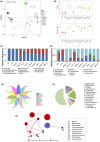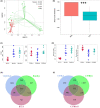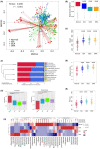Characteristics of gut microbiota in representative mice strains: Implications for biological research
- PMID: 35892142
- PMCID: PMC9434578
- DOI: 10.1002/ame2.12257
Characteristics of gut microbiota in representative mice strains: Implications for biological research
Abstract
Background: Experimental animals are used to study physiological phenomena, pathological mechanisms, and disease prevention. The gut microbiome is known as a potential confounding factor for inconsistent data from preclinical studies. Although many gut microbiome studies have been conducted in recent decades, few have focused on gut microbiota fluctuation among representative mouse strains.
Methods: A range of frequently used mouse strains were selected from 34 isolation packages representing disease-related animal (DRA), immunity defect animal (IDA), or gene-editing animal (GEA) from the BALB/c and C57BL/6J backgrounds together with normal mice, and their microbial genomic DNA were isolated from mouse feces to sequence for the exploration of gut microbiota.
Results: Mouse background strain, classification, introduced source, introduced year, and reproduction type significantly affected the gut microbiota structure (p < 0.001 for all parameters), with background strain contributing the greatest influence (R2 = 0.237). In normal groups, distinct gut microbiota types existed in different mouse strains. Sixty-four core operational taxonomic units were obtained from normal mice, and 12 belonged to Lactobacillus. Interestingly, the gut microbiota in C57BL/6J was more stable than that in BALB/c mice. Furthermore, the gut microbiota in the IDA, GEA, and DRA groups significantly differed from that in normal groups (p < 0.001 for all). Compared with the normal group, there was a significantly higher Chao1 and Shannon index (p < 0.001 for all) in the IDA, GEA, and DRA groups. Markedly changed classes occurred with Firmicutes and Bacteroidetes. The abundances of Helicobacter, Blautia, Enterobacter, Bacillus, Clostridioides, Paenibacillus, and Clostridiales all significantly decreased in the IDA, GEA, and DRA groups, whereas those of Saccharimonas, Rikenella, and Odoribacter all significantly increased.
Keywords: Bacteroidetes; Firmicutes; BALB/c mice; C57BL/6J; disease-related animal; gene-editing animal; gut microbiota; immunity defect animal; strains.
© 2022 The Authors. Animal Models and Experimental Medicine published by John Wiley & Sons Australia, Ltd on behalf of The Chinese Association for Laboratory Animal Sciences.
Conflict of interest statement
The authors declare that they have no conflicts of interest. Jianguo Guo and Chuan Qin are editorial board members of Animal Models and Experimental Medicine and a coauthors of this article. To minimize bias, they were excluded from all editorial decision making related to the acceptance of this article for publication.
Figures



Similar articles
-
Host Immunity Influences the Composition of Murine Gut Microbiota.Front Immunol. 2022 Mar 15;13:828016. doi: 10.3389/fimmu.2022.828016. eCollection 2022. Front Immunol. 2022. PMID: 35371073 Free PMC article.
-
Vancomycin-Induced Changes in Host Immunity and Behavior: Comparative Genomic and Metagenomic Analysis in C57BL/6 and BALB/c Mice.Dig Dis Sci. 2021 Nov;66(11):3776-3791. doi: 10.1007/s10620-020-06729-x. Epub 2021 Jan 1. Dig Dis Sci. 2021. PMID: 33386517
-
Observation of the Gut Microbiota Profile in C57BL/6 Mice Induced by Plasmodium berghei ANKA Infection.Front Cell Infect Microbiol. 2021 Oct 28;11:680383. doi: 10.3389/fcimb.2021.680383. eCollection 2021. Front Cell Infect Microbiol. 2021. PMID: 34778098 Free PMC article.
-
Contributions of Lactobacillus plantarum PC170 administration on the recovery of gut microbiota after short-term ceftriaxone exposure in mice.Benef Microbes. 2020 Sep 1;11(5):489-509. doi: 10.3920/BM2019.0191. Epub 2020 Aug 19. Benef Microbes. 2020. PMID: 32811176
-
Restoration of cefixime-induced gut microbiota changes by Lactobacillus cocktails and fructooligosaccharides in a mouse model.Microbiol Res. 2017 Jul;200:14-24. doi: 10.1016/j.micres.2017.04.001. Epub 2017 Apr 5. Microbiol Res. 2017. PMID: 28527760
Cited by
-
Fetal growth restriction induced by maternal gal-3 deficiency is associated with altered gut-placenta axis.Cell Death Dis. 2024 Aug 8;15(8):575. doi: 10.1038/s41419-024-06962-6. Cell Death Dis. 2024. PMID: 39117607 Free PMC article.
-
Host genetics and gut microbiota influence lipid metabolism and inflammation: potential implications for ALS pathophysiology in SOD1G93A mice.Acta Neuropathol Commun. 2024 Nov 6;12(1):174. doi: 10.1186/s40478-024-01877-x. Acta Neuropathol Commun. 2024. PMID: 39506789 Free PMC article.
-
Influence of angiotensin II on the gut microbiome: modest effects in comparison to experimental factors.Cardiovasc Res. 2024 Sep 2;120(10):1155-1163. doi: 10.1093/cvr/cvae062. Cardiovasc Res. 2024. PMID: 38518247 Free PMC article.
-
A yeast-based oral therapeutic delivers immune checkpoint inhibitors to reduce intestinal tumor burden.Cell Chem Biol. 2025 Jan 16;32(1):98-110.e7. doi: 10.1016/j.chembiol.2024.10.013. Epub 2024 Nov 20. Cell Chem Biol. 2025. PMID: 39571582
-
Immunomodulatory and cardio-protective effects of differentially originated multipotent mesenchymal stroma cells during polymicrobial sepsis in mice.Eur J Trauma Emerg Surg. 2025 Apr 20;51(1):178. doi: 10.1007/s00068-025-02862-2. Eur J Trauma Emerg Surg. 2025. PMID: 40253667 Free PMC article.
References
Publication types
MeSH terms
LinkOut - more resources
Full Text Sources

